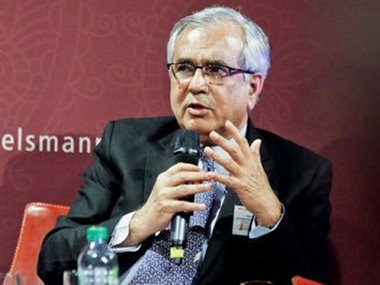Demonetisation hasn’t slowed down the economy. Instead, it is the former Reserve Bank of India governor Raghuram Rajan who should take the blame for it, says Niti Aayog Vice Chairman Rajiv Kumar. He termed the narrative as ‘false’ that post-demonetiation the economy slowed down, in an interview with Asian News International (ANI). “This is a false narrative. Leading people like P Chidambaram and our former PM [Manmohan Singh] added to this. In the post-demonetisation period, the growth rate came down not because of demonetisation but because of a declining trend in the last six quarters starting from last quarter of 2015-16 when it was as high as 9.2 percent. Every successive quarter since then it has been coming down. It was simply a continuation of a trend and not because of a shock given to it by demonetisation as has been claimed. There is no evidence to show that there is a direct link between demonetisation and the slowdown of the economy,” Kumar said.
#UPDATE Growth was declining because of rising NPAs in banking sector. Because under previous governor Mr Rajan they brought in new mechanisms to identify stressed NPAs & these continued to go up which is why banking sector stopped giving credit to industry: Rajiv Kumar https://t.co/XxEsQXtiJw
— ANI (@ANI) September 3, 2018
According to Kumar, non performing assets (NPAs) rose to Rs 10.5 lakhs crore by the middle of 2017 from Rs 4 lakh crore when the NDA government headed by Narendra Modi took charge. Kumar said it was Rajan’s revised mechanism of identifying NPAs that led to banks not giving credit to the industry. “Rajan had instituted new mechanisms to identify stressed and non-performing assets which is why the banking sector stopped giving credit to industries,” he said.
#WATCH:Niti Aayog Vice-Chairman Rajiv Kumar on allegations that #demonetisation slowed down growth says 'This is a completely false narrative and I am afraid leading people like Mr.Chidambaram and our former PM added to this.' pic.twitter.com/EeGqHjIpad
— ANI (@ANI) September 3, 2018
In some cases with the MSMEs, their credit shrank in a negative way. “Especially in the case of small-scale business, their credit actually shrank. There was a negative growth in the years. Even for the large industries, their growth shrank to 1.5 percent to 2 percent and in some quarters even negative. This has been the highest deleveraging of India’s commercial sector in the country’s economic history. Never had we seen such a continuous year after year of deleveraging of credit. This has been the primary reason for falling growth. The current government ramped up the public capital expenditure for the very reason,” he said.


)

)
)
)
)
)
)
)
)



